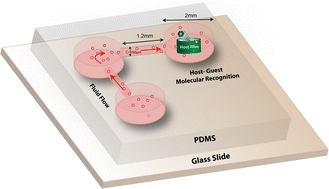Polymer multilayer films regulate macroscopic fluid flow and power microfluidic devices via supramolecular interactions†
Abstract
Self-powered supramolecular micropumps could potentially provide a solution for powerless microfluidic devices where the fluid flow can be manipulated via modulating non-covalent interactions. An attempt has been made to fabricate thin-film-based micropumps by depositing a β-cyclodextrin (‘host’) functionalized polymer on a glass slide via layer-by-layer assembly. These supramolecular micropumps turned on the fluid flow upon addition of ‘guest’ molecules to the multilayer films. The flow velocity was tuned using the concentration of the guest molecules as well as the number of host layers inside the multilayer films. Numerical modelling reveals that the solutal buoyancy, which originates from host–guest complexation, is primarily responsible for the fluid flow. In view of its potential application in self-powered devices, the thin-film-based micropump was integrated into a microfluidic device to show molecular and colloidal transport over long distances.



 Please wait while we load your content...
Please wait while we load your content...